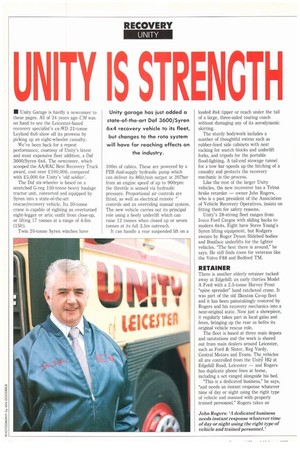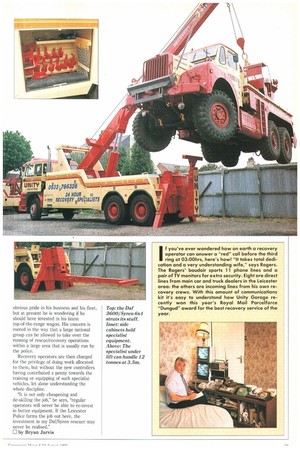UNITY IS STRENGTH
Page 40

Page 41

If you've noticed an error in this article please click here to report it so we can fix it.
Unity garage has just added a state-of-the-art Daf 3600/Syren 6x4 recovery vehicle to its fleet, but changes to the rota system will have far reaching effects on the industry.
• Unity Garage is hardly a newcomer to these pages. All of 24 years ago CM was on hand to see the Leicester-based recovery specialist's ex-WD 21-tonne Leyland 6x6 show off its prowess by picking up an eight-wheeler casualty.
We've been back for a repeat performance, courtesy of Unity's latest and most expensive fleet addition, a Daf 3600/Syren 6x4. The newcomer, which scooped the AA/RAC Best Recovery Truck award, cost over £100,000, compared with £5,000 for Unity's 'old soldier'.
The Daf six-wheeler is based on a stretched G-reg 150-tonne heavy haulage tractor unit, converted and equipped by Syren into a state-of-the-art rescue/recovery vehicle. Its 30-tonne crane is capable of righting an overturned eight-legger or artic outfit from close-up, or lifting 17 tonnes at a range of 4.6m (15ft).
Twin 20-tonne Syren winches have 100m of cables. These are powered by a PZB dual-supply hydraulic pump which can deliver its 861it/min output at 207bar from an engine speed of up to 900rpm: the throttle is sensed via hydraulic pressure. Proportional air controls are fitted, as well as electrical remote controls and an overriding manual system. The new vehicle carries out its principal role using a beefy underlift which can raise 12 tonnes when closed up or seven tonnes at its full 3.5m outreach.
It can handle a rear suspended lift on a loaded 8x4 tipper or reach under the tail of a large, three-axled touring coach without damaging any of its aerodynamic skirting.
The sturdy bodywork includes a number of thoughtful extras such as rubber-lined side cabinets with neat racking for snatch blocks and underlift forks, and tripods for the portable flood-lighting. A tail-end stowage tunnel for a tow bar speeds up the hitching of a casualty and protects the recovery mechanic in the process.
Like the rest of the larger Unity vehicles, the new recoverer has a Telma brake retarder — owner John Rogers, who is a past president of the Association of Vehicle Recovery Operatives, insists on fitting them for safety reasons.
Unity's 28-strong fleet ranges from Iveco Ford Cargos with sliding backs to modern 6x4s. Eight have Steve Young's Syren lifting equipment, but Rodgers swears by Roger Dyson Slidebed bodies and Boniface underlifts for the lighter vehicles. "The best there is around," he says. He still finds room for veterans like the Volvo F88 and Bedford TM.
RETAINER
There is another elderly retainer tucked away at Edgehill: an early thirties Model A Ford with a 2.5-tonne Harvey Frost "spine spreader" hand ratcheted crane. It was part of the old Ilkeston Co-op fleet and it has been painstakingly restored by Rogers and his recovery mechanics into a near-original state. Now just a showpiece, it regularly takes part in local galas and fetes, bringing up the rear as befits its original vehicle rescue role.
The fleet is based at three main depots and outstations and the work is shared out from main dealers around Leicester, such as Ford & Slater, Reg Vardy, Central Motors and Evans, The vehicles all are controlled from the Unity HQ at Edgehill Road, Leicester — and Rogers has duplicate phone lines at home, including a set ranged alongside his bed.
"This is a dedicated business," he says, "and needs an instant response whatever time of day or night using the right type of vehicle and manned with properly trained personnel." Rogers takes an obvious pride in his business and his fleet, but at present he is wondering if he should have invested in his latest top-of-the-range wagon. His concern is rooted in the way that a large national group can be allowed to take over the running of rescue/recovery operations within a large area that is usually run by the police.
Recovery operators are then charged for the privilege of doing work allocated to them, but without the new controllers having contributed a penny towards the training or equipping of such specialist vehicles, let alone understanding the whole discipline.
"It is not only cheapening and de-skilling the job," he says, "regular operators will never be able to re-invest in better equipment. If the Leicester Police farms the job out here, the investment in my Daf/Syren rescuer may never be realised."
by Bryan Jarvis
















































































